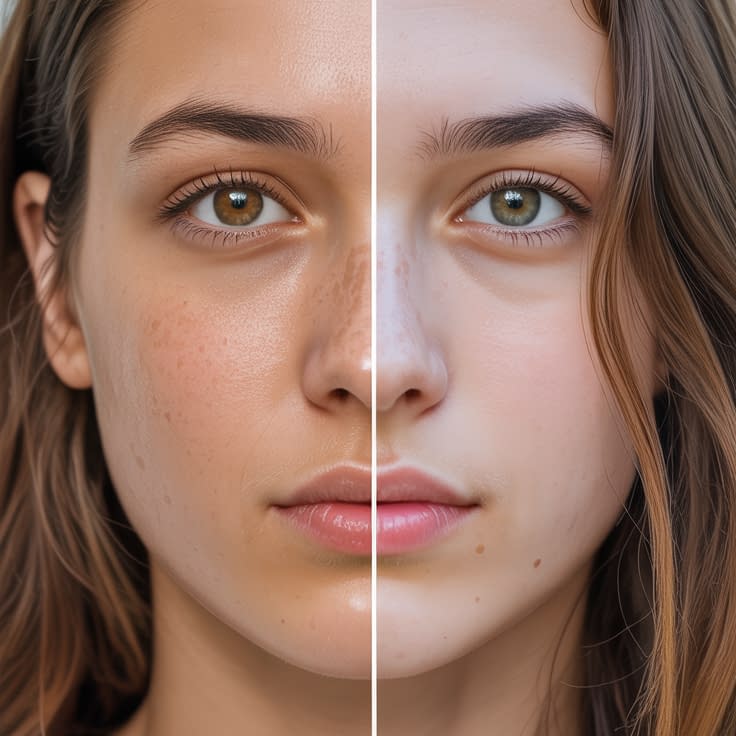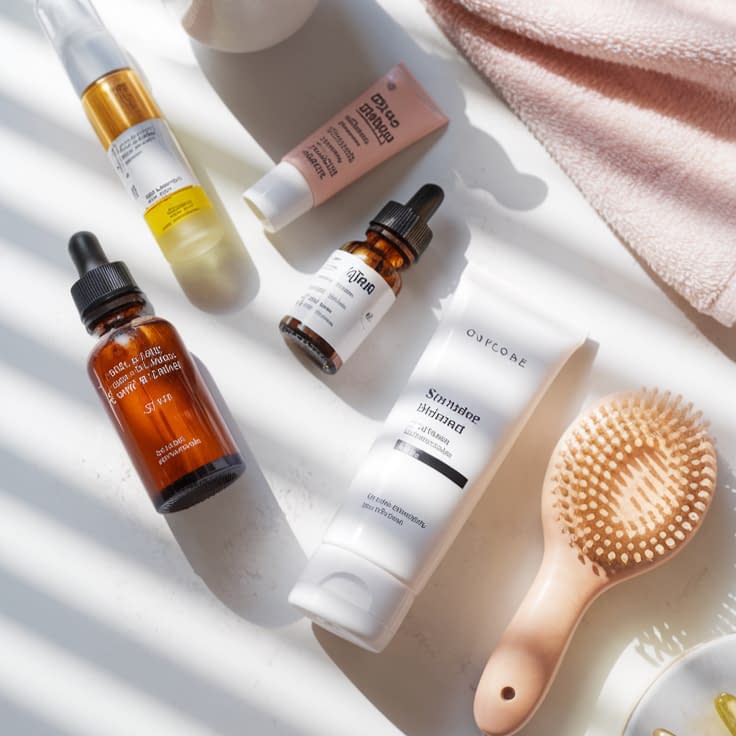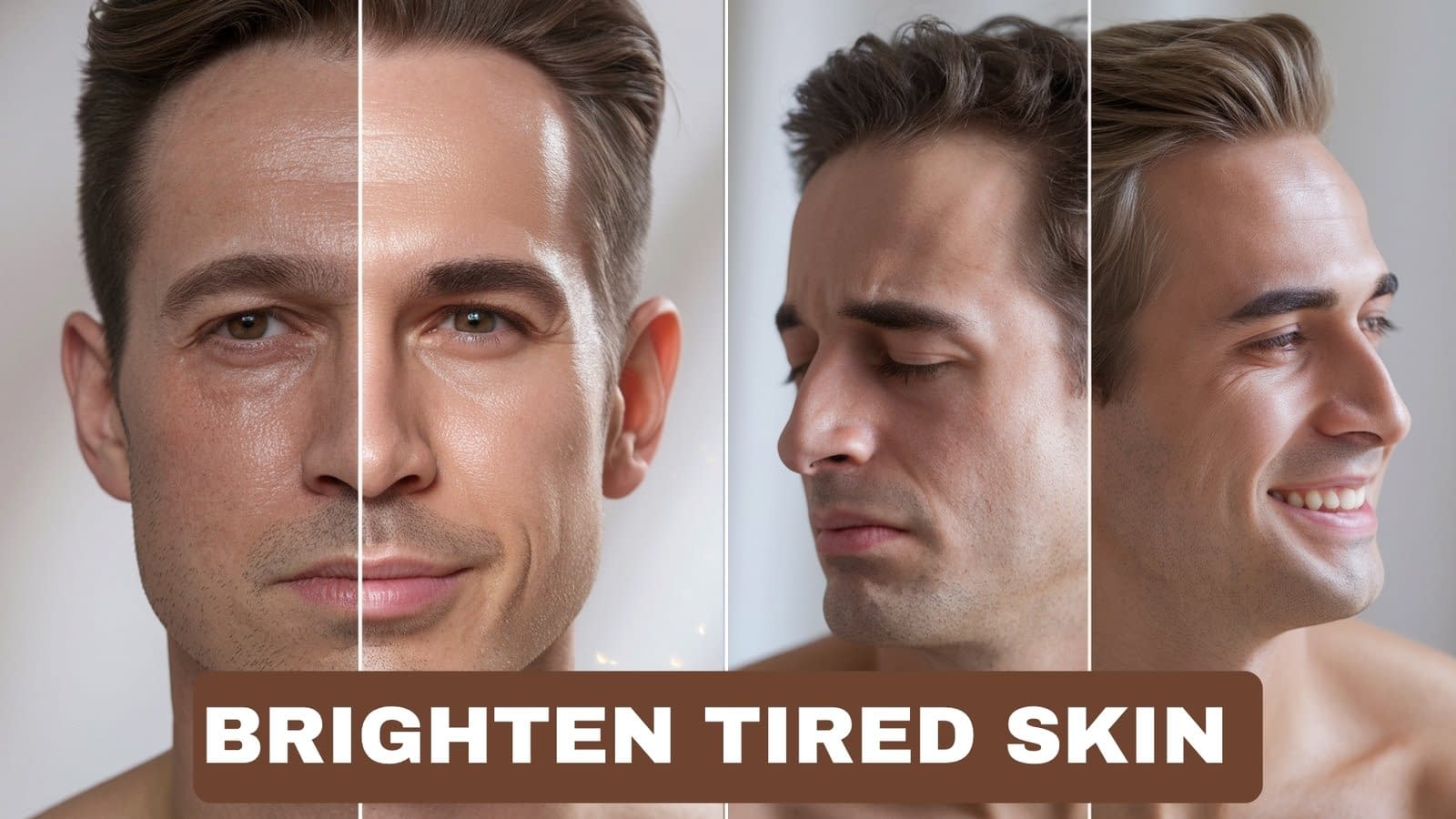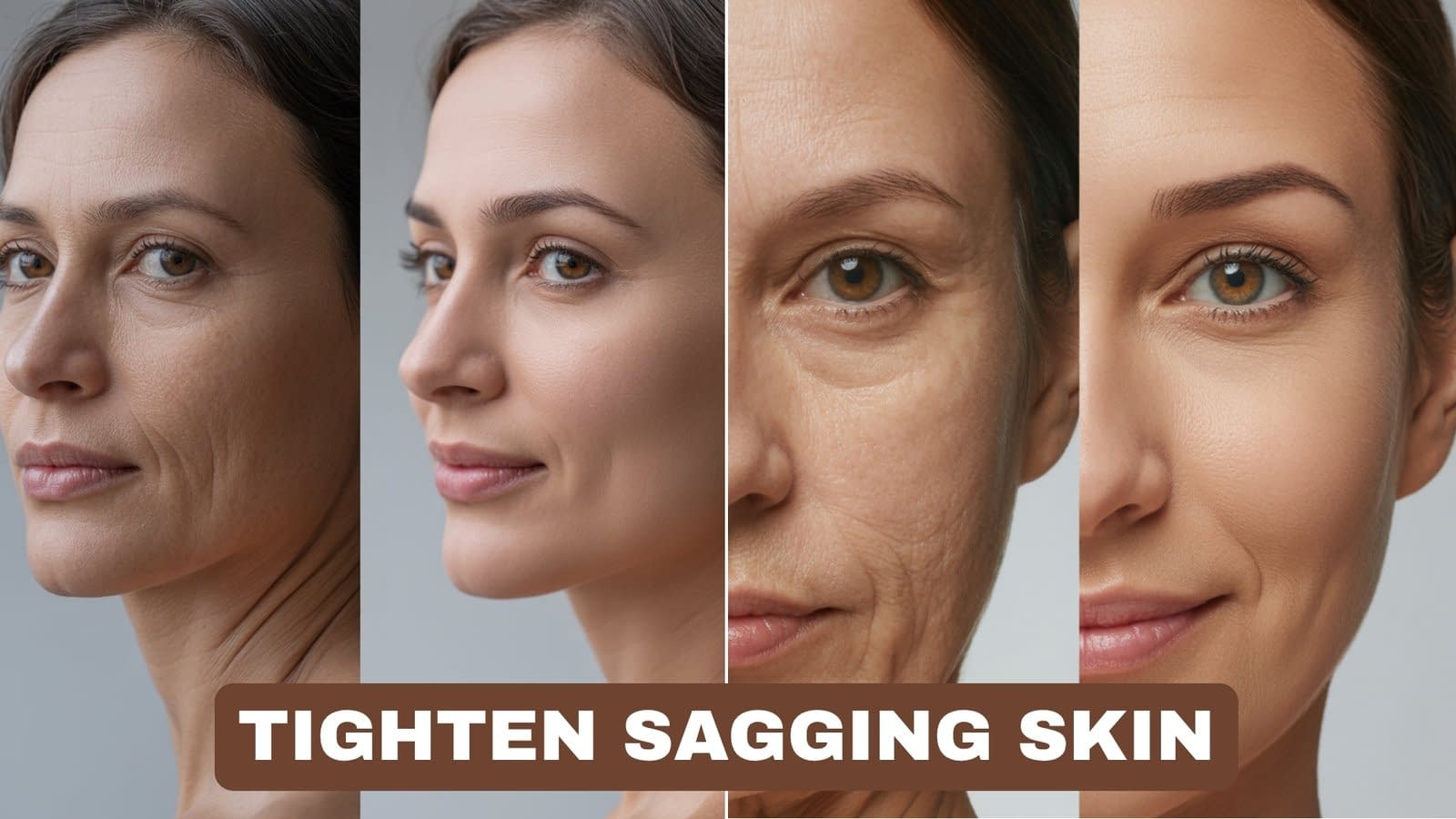Note up front: when people say “get pale skin” they usually mean “a lighter, more even, brighter complexion” rather than changing their natural ethnicity or genetics. This guide focuses on safe, healthy, and natural ways to brighten and even out your skin tone — not on dangerous bleaching, harsh chemicals, or unrealistic quick fixes. You’ll find long-term, gentle methods that protect your skin, reduce pigmentation, and help your natural tone look its healthiest and most luminous.
Why Natural Skin Brightening Matters

There’s a big difference between healthy brightening and aggressive skin-bleaching. Natural brightening aims to reduce sun-induced darkening, fade uneven pigmentation, and improve skin brightness by supporting your skin’s repair systems. Harsh chemical lightening (unregulated hydroquinone, steroids, etc.) can damage the skin barrier, thin skin, and cause rebound darkening. Prioritize methods that preserve the skin’s health — prevention (sunscreen), gentle renewal (exfoliation, retinoids as advised by a pro), hydration, and nutrition.
What to expect: gradual improvement over weeks to months, not instant dramatic whitening. If you have severe hyperpigmentation, melasma, or dark spots, see a dermatologist — professional treatments plus medical-strength products may be appropriate and safer than DIY extremes.
Always Wear Sunscreen: Your First Step to Prevent Darkening
Sun exposure is the main cause of new pigmentation and the major reason skin darkens over time. Daily sunscreen is non-negotiable.
Step-by-step sunscreen plan
- Choose a broad-spectrum SPF 30+ (SPF 50 if you’re very fair or will be outdoors a lot). “Broad-spectrum” protects against both UVA (aging) and UVB (burning).
- Apply every morning to all exposed skin — face, neck, ears, hands, and any chest/arms you leave uncovered. Don’t skip cloudy days; UVA penetrates clouds and windows.
- Use the right amount: about a nickel-sized dollop for face/neck, and more for chest/arms/hands. Many people apply too little.
- Reapply every 2 hours outdoors and immediately after swimming or heavy sweating. If you use makeup, keep a facial sunscreen spray or powder for touch-ups.
- Add physical barriers: wide-brim hats, UPF clothing, sunglasses, and shade during peak sun hours (10am–4pm) multiply your protection.
- Tip: Apply sunscreen as the last step of your morning skincare routine; wait a minute for it to set before makeup.
Why this works: preventing UV exposure stops new melanin signals and gives other brightening measures a chance to work without being undone.
Stay Hydrated: Water for Clear, Radiant Skin
Hydration keeps skin plump and healthy; although water alone won’t lighten pigment, well-hydrated skin reflects light better and looks brighter.
Step-by-step hydration habits
- Daily water target: aim for steady intake over the day — commonly 1.5–3 liters depending on body size, climate, and activity. Use urine color (pale straw) as a quick guide.
- Small frequent sips beat occasional large amounts. Carry a refillable bottle.
- Hydrating foods: cucumbers, watermelon, oranges, tomatoes, and soups contribute both fluids and vitamins.
- Limit dehydrators: alcohol and excessive caffeine dehydrate; if you drink them, balance with extra water.
- Topical hydration: use humectants (hyaluronic acid, glycerin) in your serums/lotions to bind water to the skin and boost a brighter look.
Why this works: plump, hydrated skin reduces the appearance of dullness and makes color look more even.
Exfoliate Regularly: Remove Dead Skin Cells for a Lighter Tone

Dead surface cells make skin look dull and darker. Regular, gentle exfoliation reveals fresher, brighter skin underneath — but do it safely.
Step-by-step exfoliation guide
- Pick your method:
- Chemical exfoliants: AHAs (lactic, glycolic) brighten and loosen pigmented cells; BHAs (salicylic) help oily, acne-prone skin. PHAs (gluconolactone) are gentler for sensitive skin.
- Physical exfoliants: soft scrubs, konjac sponges, or very gentle brushes — avoid harsh particles (coffee grounds, crushed shells) that create micro-tears.
- Start slow:
- Chemical: begin once a week with a low concentration (e.g., glycolic 5–8% or lactic 5–10%).
- Physical: exfoliate 1×/week, increasing only if your skin tolerates it.
- Technique:
- Chemical: follow product instructions (often apply to clean, dry skin and rinse or leave on as directed). Always follow with moisturizer.
- Physical: use light pressure, circular motions, and rinse thoroughly.
- Avoid overdoing it: 2–3×/week is the upper limit for most people. Over-exfoliating causes irritation, inflammation, and rebound pigmentation.
- Post-care: apply sunscreen during the day (exfoliated skin is more sun-sensitive) and a soothing moisturizer after exfoliation.
Why this works: it speeds removal of hyperpigmented surface cells and improves product penetration for brightening ingredients.
Moisturize Daily: Keep Skin Soft and Even-Toned
Dry, flaky skin hides a true, even tone. Moisturizing smooths texture and reduces dull, shadowed patches.
Step-by-step moisturizing routine
- Select the right product:
- Dry skin → richer creams or ointments with ceramides, fatty acids, shea butter.
- Oily/combination → lightweight lotions with humectants (hyaluronic acid, glycerin) and non-comedogenic oils.
- Sensitive or reactive → fragrance-free, minimal ingredient lists.
- Apply to damp skin: pat skin lightly after cleansing and apply moisturizer to lock in water.
- Layer smart: use hyaluronic acid serum first (on damp skin), then your moisturizer, and a facial oil as the last layer at night if needed.
- Target dry patches: use occlusive balms on elbows, knees, and hands. Overnight leave-on masks are great once weekly for boost.
- Consistency: moisturize morning and night for best tone and texture results.
Why this works: a healthy barrier reduces flaking and shadows, helping skin look lighter and more uniform.
Eat a Skin-Brightening Diet: Nutrients That Help Lighten Skin
What you eat affects collagen formation, skin turnover, and antioxidant defense — all important for a brighter tone.
Step-by-step dietary tips
- Load up on vitamin C: citrus, strawberries, kiwi, red peppers — vitamin C supports collagen and helps even tone.
- Eat antioxidant-rich foods: berries, dark leafy greens, nuts, and green tea help neutralize oxidative damage that worsens pigmentation.
- Include healthy fats: omega-3s (salmon, chia, walnuts) keep the barrier supple and reduce inflammation.
- Avoid high-glycemic foods: refined sugars and processed carbs can promote inflammation and may worsen discoloration in some people.
- Consider supplements carefully: vitamin C, vitamin E, and omega-3 supplements may help if your diet is lacking, but consult a healthcare provider first. Collagen peptides can support skin firmness, which indirectly improves perceived brightness.
- Balance and hydration: combine a nutrient-dense plate with steady water intake.
Why this works: your skin rebuilds from the inside — the right nutrients support repair and an even pigment over time.
Use Natural Face Masks and Remedies — Safely

DIY masks can brighten and soothe skin, but use gentle, non-irritating ingredients and patch-test everything.
Safe, effective DIY masks (recipes & frequency)
- Yogurt + honey (gentle brightener)
- Mix 1 tbsp plain yogurt + 1 tsp honey. Apply 10–15 minutes, rinse with lukewarm water. 1–2×/week.
- Why: lactic acid in yogurt gently exfoliates; honey soothes and hydrates.
- Turmeric spot-mask (for targeted spots)
- Mix a very small pinch of turmeric with 1 tsp yogurt or aloe vera gel. Apply only to dark spots for 5–10 minutes; rinse carefully. Use sparingly (once a week) — turmeric can temporarily stain skin/clothes.
- Caution: patch-test for staining and irritation.
- Aloe vera + vitamin C booster (soothing brightener)
- Mix 1 tbsp pure aloe vera gel with a few drops of a stable vitamin C serum (if available) and apply 10–15 minutes; rinse. 1–2×/week.
- Why: aloe soothes inflammation; vitamin C brightens (but be careful with DIY mixing — store-bought stable serums are more predictable).
- Oat + banana calming mask
- Blend 1 tbsp oats + 1/2 mashed banana until paste-like. Apply 10–15 minutes. Good for sensitive, red, or irritated skin. Weekly.
- Papaya enzyme mask (gentle natural exfoliant)
- Mash a small piece of ripe papaya and apply 5–10 minutes (contains papain). Works as a mild enzyme exfoliant; do not leave on longer as it can irritate. 1×/week.
Safety rules for natural remedies
- Patch test: apply a tiny amount to inner forearm for 24–48 hours. If redness, itching, or burning occurs, don’t use.
- Avoid lemon/straight citrus on face: common DIY lemon juice is acidic and photosensitizing — it often causes irritation and post-inflammatory darkening.
- Use clean tools and fresh ingredients. Discard DIY masks after one use.
- Be patient — natural masks give subtle improvements; don’t expect radical bleaching.
Why this works: some natural ingredients contain mild acids, enzymes, or antioxidants that gently brighten and calm the skin when used safely.
Get Adequate Sleep: Rest for Radiant Skin
Sleep is the body’s repair time — growth hormone and restorative processes help skin turnover and reduce inflammation.
Step-by-step sleep hygiene for better skin
- Aim for 7–9 hours nightly and keep a consistent bedtime/wake time.
- Wind-down routine: dim lights, avoid screens 60 minutes before bed, read, practice light stretching or breathing.
- Optimize environment: cool room, breathable bedding, minimal light/noise.
- Nighttime skincare: cleanse, apply any prescribed nighttime treatments (retinoids as directed), then moisturize — let the skin repair overnight.
- Avoid late heavy alcohol: it fragments sleep and dehydrates skin.
- Tip: side-sleepers with pillow friction can cause sleep creases and uneven tone over time — use silk pillowcases to reduce friction.
Why this works: better sleep equals more efficient skin repair, less inflammation, and fewer dark circles and dull patches.
Avoid Tanning and Limit Sun Exposure
The most reliable way to stay lighter naturally is to avoid the cause of most long-term darkening: UV.
Step-by-step sun-avoidance strategy
- No tanning beds — they are strongly linked to pigmentation and skin cancer.
- Limit midday sun: seek shade and plan outdoor activities in early morning or late afternoon.
- Wear protective clothing: hats, long sleeves, and UPF fabrics make a big difference.
- Use physical sunscreens: zinc oxide or titanium dioxide are less irritating for some people and provide reliable protection.
- Be cautious near reflective surfaces: sand, water, and snow increase sun exposure.
- Post-sun care: if you accidentally get sunburn, treat promptly (cool compresses, aloe vera, hydration) and skip active brightening for a few days while skin recovers.
Why this works: stopping UV exposure prevents new melanin production and lets gradual brightening efforts show results.
Practice Gentle Skincare: Avoid Harsh Chemicals

Harsh bleaches, strong acids used incorrectly, or steroid creams not prescribed can damage the skin and cause long-term problems. Gentle, consistent care is far safer.
Step-by-step gentle skincare rules
- Avoid DIY bleaching with household chemicals or unregulated products. These can cause irritation, thinning, and paradoxical darkening.
- Limit irritating actives: high-strength acids, bleaching agents, and harsh scrubs should be used only as directed and introduced one at a time.
- Patch test all new actives for 48 hours and start with low frequency (once a week) before increasing.
- Use a mild cleanser (pH-balanced if possible) and avoid over-washing. Over-cleaning increases dryness and causes compensatory pigmentation.
- If you use prescription products (e.g., tretinoin or dermatologist-prescribed lightening agents), follow instructions, use sunscreen, and have follow-up with your provider.
- When in doubt, simplify: if irritation appears, stop everything but a gentle cleanser and a soothing moisturizer until the skin calms down.
Why this works: protecting the barrier prevents inflammation and post-inflammatory hyperpigmentation — key steps in a natural brightening strategy.
Final Words
Natural brightening is a marathon, not a sprint. The safest and most reliable path to a lighter, even, radiant complexion is to prevent new darkening (sunscreen + sun avoidance), gently renew the surface (exfoliation + retinoids under guidance), hydrate and repair the barrier (moisturizers + humectants), and support the body internally (water + diet + sleep).
A practical starter plan (first 8 weeks)
- Daily AM: gentle cleanse → hydrating serum (hyaluronic acid) → moisturizer → broad-spectrum SPF 30+
- Daily PM: gentle cleanse → targeted serum (vitamin C or prescribed retinoid as tolerated) → moisturizer
- Weekly: 1 gentle exfoliation session + 1 nourishing mask
- Lifestyle: hydrate, eat antioxidant-rich foods, aim for consistent sleep, avoid tanning and tanning beds
Be realistic: mild evening and smoothness can appear within weeks; more significant fading of long-standing dark spots can take months. If you have stubborn pigmentation (melasma, post-inflammatory hyperpigmentation, or large dark spots), consult a dermatologist — professional guidance and treatments are often the safest, fastest route.








